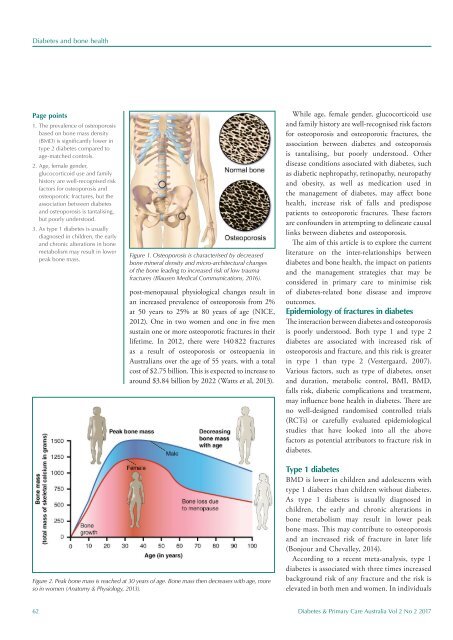DPCA2-2_issue
You also want an ePaper? Increase the reach of your titles
YUMPU automatically turns print PDFs into web optimized ePapers that Google loves.
Diabetes and bone health<br />
Page points<br />
1. The prevalence of osteoporosis<br />
based on bone mass density<br />
(BMD) is significantly lower in<br />
type 2 diabetes compared to<br />
age-matched controls.<br />
2. Age, female gender,<br />
glucocorticoid use and family<br />
history are well-recognised risk<br />
factors for osteoporosis and<br />
osteoporotic fractures, but the<br />
association between diabetes<br />
and osteoporosis is tantalising,<br />
but poorly understood.<br />
3. As type 1 diabetes is usually<br />
diagnosed in children, the early<br />
and chronic alterations in bone<br />
metabolism may result in lower<br />
peak bone mass.<br />
Figure 1. Osteoporosis is characterised by decreased<br />
bone mineral density and micro-architectural changes<br />
of the bone leading to increased risk of low trauma<br />
fractures (Blausen Medical Communications, 2016).<br />
post-menopausal physiological changes result in<br />
an increased prevalence of osteoporosis from 2%<br />
at 50 years to 25% at 80 years of age (NICE,<br />
2012). One in two women and one in five men<br />
sustain one or more osteoporotic fractures in their<br />
lifetime. In 2012, there were 140 822 fractures<br />
as a result of osteoporosis or osteopaenia in<br />
Australians over the age of 55 years, with a total<br />
cost of $2.75 billion. This is expected to increase to<br />
around $3.84 billion by 2022 (Watts et al, 2013).<br />
While age, female gender, glucocorticoid use<br />
and family history are well-recognised risk factors<br />
for osteoporosis and osteoporotic fractures, the<br />
association between diabetes and osteoporosis<br />
is tantalising, but poorly understood. Other<br />
disease conditions associated with diabetes, such<br />
as diabetic nephropathy, retinopathy, neuropathy<br />
and obesity, as well as medication used in<br />
the management of diabetes, may affect bone<br />
health, increase risk of falls and predispose<br />
patients to osteoporotic fractures. These factors<br />
are confounders in attempting to delineate causal<br />
links between diabetes and osteoporosis.<br />
The aim of this article is to explore the current<br />
literature on the inter-relationships between<br />
diabetes and bone health, the impact on patients<br />
and the management strategies that may be<br />
considered in primary care to minimise risk<br />
of diabetes-related bone disease and improve<br />
outcomes.<br />
Epidemiology of fractures in diabetes<br />
The interaction between diabetes and osteoporosis<br />
is poorly understood. Both type 1 and type 2<br />
diabetes are associated with increased risk of<br />
osteoporosis and fracture, and this risk is greater<br />
in type 1 than type 2 (Vestergaard, 2007).<br />
Various factors, such as type of diabetes, onset<br />
and duration, metabolic control, BMI, BMD,<br />
falls risk, diabetic complications and treatment,<br />
may influence bone health in diabetes. There are<br />
no well-designed randomised controlled trials<br />
(RCTs) or carefully evaluated epidemiological<br />
studies that have looked into all the above<br />
factors as potential attributors to fracture risk in<br />
diabetes.<br />
Figure 2. Peak bone mass is reached at 30 years of age. Bone mass then decreases with age, more<br />
so in women (Anatomy & Physiology, 2013).<br />
Type 1 diabetes<br />
BMD is lower in children and adolescents with<br />
type 1 diabetes than children without diabetes.<br />
As type 1 diabetes is usually diagnosed in<br />
children, the early and chronic alterations in<br />
bone metabolism may result in lower peak<br />
bone mass. This may contribute to osteoporosis<br />
and an increased risk of fracture in later life<br />
(Bonjour and Chevalley, 2014).<br />
According to a recent meta-analysis, type 1<br />
diabetes is associated with three times increased<br />
background risk of any fracture and the risk is<br />
elevated in both men and women. In individuals<br />
62 Diabetes & Primary Care Australia Vol 2 No 2 2017
















